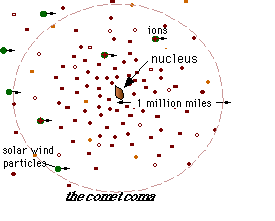This is one of the latest images of comet Hale-Bopp. Notice the intense tail
Click on image for full size
National Astronomical Observatory of Japan
Comet Hale-Bopp
Comet Hale-Bopp was one of the brightest comets of all time. Astronomers witnessed the
comet spew out intermittent bursts of dust. The surface seemed to be an incredibly dynamic place, with 'vents' being turned on and off.
The nucleus structure itself is more complex than astronomers had thought before. In addition, the nucleus is tremendously large. Astronomers have estimated
Hale-Bopp's nucleus to be 19-25 miles (30-40 kilometers) in diameter. Comets
are thought to have a nucleus of about 3 miles (5 kilometers) on average.
You might also be interested in:

Scientists are using a new satellite to view the far side of the Sun. They can now find solar storms days before they reach Earth! The Solar and Heliospheric Observatory (SOHO) satellite is doing things
...more
Comet Hale-Bopp was one of the brightest comets of all time. Astronomers witnessed the comet spew out intermittent bursts of dust. The surface seemed to be an incredibly dynamic place, with 'vents' being
...more
Six spacecraft flew to Halley's comet in 1986. There were two spacecraft launched from Japan, named Suisei and Sakigake, and two from the Soviet Union, named Vega 1 & 2. One spacecraft, ICE, was from the
...more
Astronomers have noticed a group of comets which they call the Jupiter Family of Comets. This family of comets is to be found circling between Jupiter and the sun, as shown in this picture. The comets
...more
Scientists have learned a great deal from the crash of comet Shoemaker-Levy 9. Scientists traced the orbit of the comet backwards in time to guess its origin. The crash of a comet like Shoemaker-Levy 9
...more
Mathematical theory suggests that comet Shoemaker-Levy 9 was likely a short-period comet which was captured into orbit around Jupiter in 1929. This orbit ended with a collision of the comet with Jupiter
...more
As the ices of the comet nucleus evaporate, they expand into a large cloud around the middle part of the comet. This cloud, called the coma, is the atmosphere of the comet. It can extend for millions of
...more














